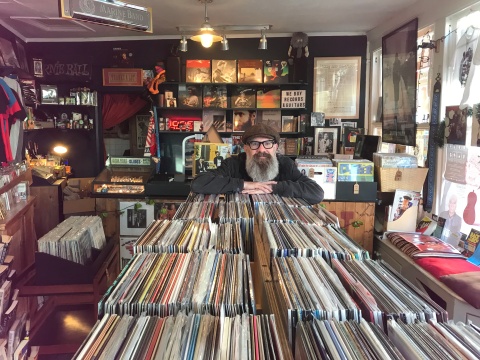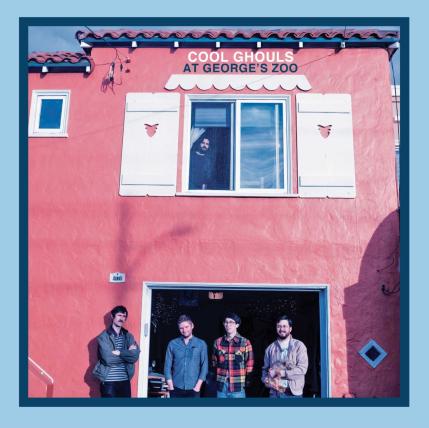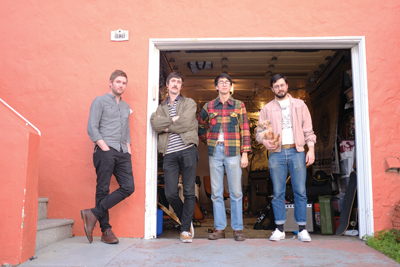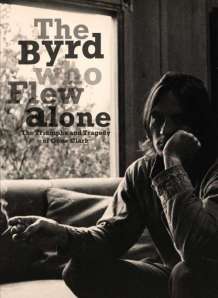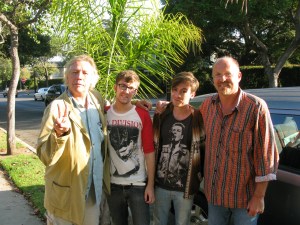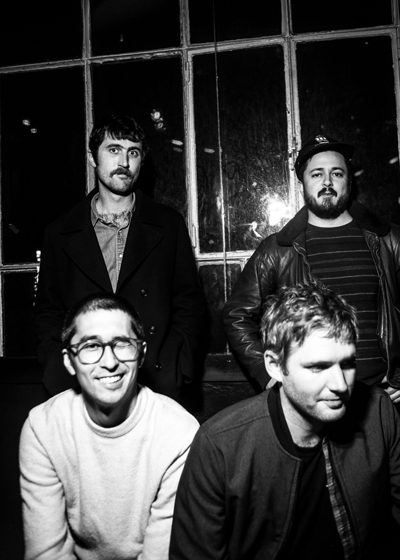
San Francisco’s Cool Ghouls (Pat McDonald – guitar/vocals; Pat Thomas – bass/vocals; Ryan Wong – guitar/vocals and Alex Fleshman – drums) turn 10 this year and release their fourth album, At George’s Zoo, in March.
It’s their best and most diverse record yet – a mix of Byrdsy psych, ’60s-style garage rock and gorgeous, Beach Boys/Jimmy Webb-inspired pop, with harmonies, piano, horns and lush strings.
“We didn’t have any expectations going into this record – we just wanted to have full control over the production and the time we spent recording,” they tell Say It With Garage Flowers.
Q&A
How’s it going? What’s it like in San Francisco and how has the city handled the pandemic?
Pat Thomas: It’s going pretty good. San Francisco is a little chilly outside. It’s been raining recently. I guess the city government here has done a decent job handling the pandemic compared with other governments, but they could do more. The vaccine rollout could be more aggressive and the mayor seems too eager to “restart the economy.”
How has lockdown affected you – as people and also as a band? Have you had to radically alter any of your plans?
PT: Plans weren’t altered that much, band-wise. Before 2020 we were already factoring in a lot of downtime, as our guitarist, Ryan, is living all the way in Denver at the moment. We wanted to release At George’s Zoo in June of 2020, but had to postpone it, obviously.
Are you worried about the future of live music, post-Covid? What are your hopes and fears? How have you been coping with lockdown?
PT: I’m not too worried about the future of live music – I don’t really see how it couldn’t bounce back eventually and start to feel pretty normal. Bands will tour, people will go to shows, etc. A lot of small venues have been lost and bands will have to contend with that. Who knows, maybe people will be moved to open more venues in response. Lockdown is lonely – I think everyone feels that to some degree.
Cool Ghouls are 10 years old in 2021 – happy birthday! How are you celebrating? How does it feel to be 10?
PT: We’re not really celebrating because we’re all in lockdown. I guess releasing a record is kind of like a celebration. It feels pretty good to be 10. It’s pretty similar to being nine, except cooler.
‘I’m not too worried about the future of live music – I don’t really see how it couldn’t bounce back eventually and start to feel pretty normal. A lot of small venues have been lost and bands will have to contend with that’
Let’s talk about the new album. Was it written and recorded pre-Covid? When and where did you make it?
PT: Yep. We recorded it at our friend Robby Joseph’s house in the Outer Sunset neighbourhood in San Francisco, in the fall and winter of 2018.
What were the sessions like?
Ryan Wong: The recording environment was really important this time around. We started every session with a beer run and a family meal and talked about what we were going to do that day. Everything was recorded live and then we overdubbed what we had to. Robby laid it down on an Otari MX5050 [tape machine].
What did you want to achieve with the new record? It’s your most expansive album yet, with bigger, richer arrangements, and horns and strings. What prompted that move?
RW: We didn’t have any expectations going into it. After recording Gord’s Horse [digital-only EP from 2017] by ourselves, we just wanted to have full control over the production and the time we spent recording. Ryan was moving to Denver, so we just laid whatever ideas we had to tape before he left. As far as the arrangements, I think we’ve just grown over time and the music reflects that on this one.
Who writes the songs and how do you arrange them? What’s the process?
RW: We all write our own songs. So once the basic structure/idea is hashed out we bring it to the band to work on. Everyone has a hand in the final product.
I think At George’s Zoo is your best record yet. Where did the title come from?
RW: Thanks. George’s Zoo is a liquor store in the Outer Sunset that we frequented while recording. Robby’s neighbour was also named George and he left some feedback on his garage door a few times…Ha!

‘The recording environment was really important. We started every session with a beer run and a family meal and talked about what we were going to do that day. Everything was recorded live and then we overdubbed what we had to’
The opening track on the album, It’s Over, is wonderful. It has a great horn arrangement, a Beach Boys-style intro and some lovely harmonies. There’s also a bit of The Notorious Byrd Brothers about it – some psych-soul going on…
PT: Thanks. Yeah. The Notorious Byrd Brothers is a great record. I bought the Tibetan handbells you hear at the beginning of the song at one of those hippy gift shops on Haight St, not far from my apartment.
What can you tell me about the first single, Helpless Circumstance? There’s a psychedelic-rock feel to it, as well as more Beach Boys…
PT: It’s a pretty simple tune. One of those songs that sprouts from a dumb riff you play absent-mindedly at practice between actual songs you’re practising. Pat M was feeling lovey-dovey, so gave it some sweet and soft lyrics. He thinks the song sounds lavender in colour.
The new single, The Way I Made You Cry, is a great piece of soulful, Brian Wilsonesque piano pop, with horns and harmonies. It’s beautiful. Any thoughts on it?
PT: Thank you. No thoughts on it really. The song pretty much communicates everything about itself better than I could with words.
Land Song is gorgeous orch-pop. It has a Jimmy Webb / Beach Boys Pet Sounds-era feel. What can you tell me about it?
RW: We’re real proud of this one. The Pats actually wrote this song together. It was definitely pulling from the Jimmy Webb playbook, but we were also listening to a lot of Canterbury bands at the time. Early King Crimson was also in the mix. Dylan Edrich added the strings and Henry Baker laid down the piano. Props to those two.
It’s not even spring yet, but Surfboard is the song of the summer and I Was Wrong has a definite Pet Sounds / Surf’s Up feel. You do sound like you’ve been listening to a lot of Beach Boys…
PT: Those songs rule. They’re so good. Surfboard started out as a joke song. I was going to change the lyrics but I just kept coming back to ‘surfboard…’
The song 26th St. Blues sounds more like the Cool Ghouls of old – it’s very ’60s garage rock.
Pat McDonald: It’s ‘60s garage rock for sure. And it was inspired by the dire housing crisis in San Francisco. It’s pretty wild to see a place change so rapidly before your eyes. There’s a lot of frustration and powerlessness in the song, which gives it its rougher edge.
What music – new and old – have you been enjoying recently? What’s been your lockdown soundtrack?
PM: Fun House by The Stooges. Pretty much exclusively that.
What’s your preferred way of listening to music – and why?
PM: In my headphones at work, so I don’t have to hear my dumbass co-workers talking about GameStop stocks.
Finally, what are your plans for the rest of the year?
RW: We’re not really sure. This year kind of seems like a wash too. We’re looking forward to playing these songs live at some point.
At George’s Zoo by Cool Ghouls is released on March 12 – Empty Cellar / Melodic Records (UK).
https://coolghouls420.bandcamp.com/album/at-georges-zoo
